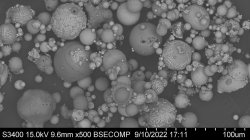Professor’s work on coal ash in the environment attracting media attention
Posted in: CSAM Research, Earth & Environmental Studies

Montclair State University Acting Vice Provost for Research and Professor of Earth and Environmental Studies, Dr. Stefanie Brachfeld, is co-author on a new study demonstrating the presence of coal combustion residuals (“coal ash”) in the bottom sediment of 5 North Carolina recreational lakes. The team integrated microscopy, magnetic methods, and geochemical tracers to document the presence of these distinctive particles. Harmful elements in coal such as heavy metals and radioactive elements are concentrated in the ash when coal is burned and solid carbon is converted to carbon dioxide.
Dr. Brachfeld, with laboratory assistance from Dr. Melissa Hansen, led the magnetic work. “Burning coal creates visually and magnetically distinctive iron-rich ferrospheres. They provide a fingerprint for detecting coal ash in the environment, and tracking mechanical and chemical evolution of the ash after burial in lake sediment.” The study demonstrates that coal ash particles are entering the environment, and not strictly through catastrophic events like the 2008 Kingston Fossil Plant coal ash spill. Atmospheric emissions of coal ash prior to the Clean Air Act may have settled onto nearby land and then washed into the lakes. Ash may be transported to lakes by overland runoff of precipitation, and ordinary effluent from the storage ponds may leak into the lakes. The study, conducted with colleagues at Duke University and Appalachian State University, has been covered by the Charlotte Observer, North Carolina National Public Radio, Science Daily and Nature World News.
The study is published in Environmental Science and Technology, and will be the subject of three presentations at the upcoming Fall 2022 Meeting of the Geological Society of America, GSA Connects 2022.
